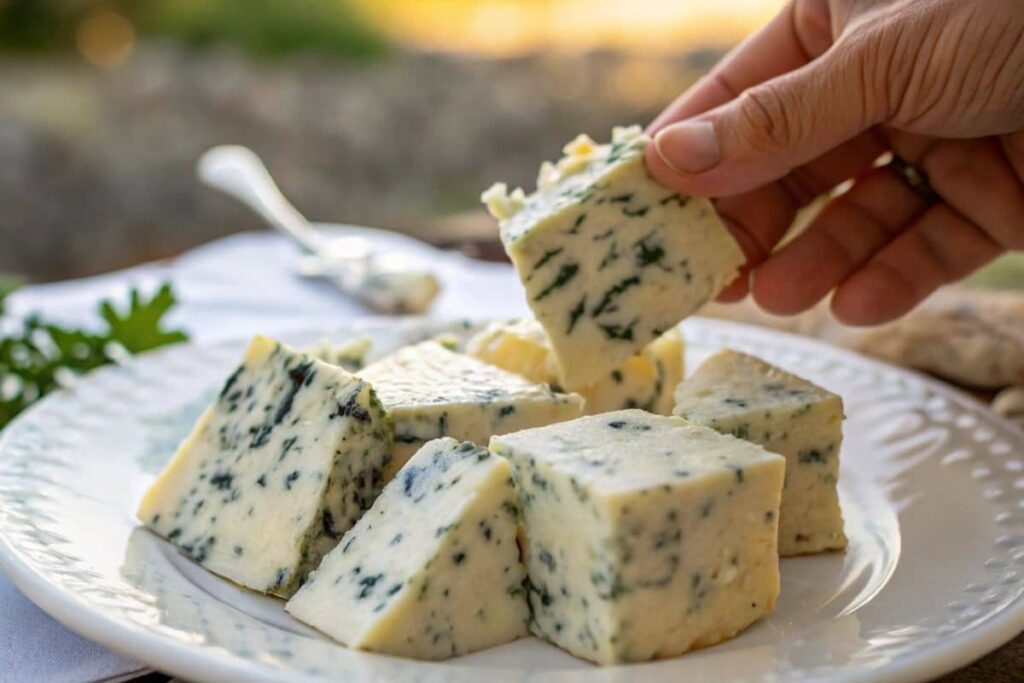Blue cheese has always been a star ingredient in the world of cheeses. With its distinctively bold flavor and creamy texture, it’s loved by many and perhaps an acquired taste for others. Whether you’re a fan of its tangy punch or curious about its unique moldy appearance, blue cheese adds a gourmet touch to any dish. But what happens when you have leftover blue cheese and wonder, “Can I freeze blue cheese?” Let’s dive deep into the surprising facts and everything you need to know.
Table of Contents

Freezing Blue Cheese
What Is Blue Cheese?
Blue cheese is a type of cheese that’s been cultured with specific mold strains—usually Penicillium roqueforti. This mold gives it the characteristic blue veins, intense flavor, and slightly crumbly texture. Some popular types include Roquefort, Stilton, and Gorgonzola.
“Blue cheese isn’t just food; it’s an experience! Its flavor profile can range from mild and creamy to sharp and tangy, depending on the variety.”
Why Is Blue Cheese Unique?
What sets blue cheese apart is its mold. While most of us avoid moldy foods, blue cheese’s edible mold is safe and contributes to its unique texture and taste. Its production process involves piercing the cheese to create air pockets, allowing the mold to grow into beautiful veins.
The Science Behind Freezing Cheese
Cheese is a living product. Its texture, taste, and overall quality can change significantly when exposed to freezing temperatures. Blue cheese, due to its high moisture content and mold culture, is particularly sensitive. However, freezing is possible if done correctly.
Freezing halts the growth of mold and bacteria, preserving the cheese for extended periods. But, like a garden paused in winter, the texture and flavor might not be as vibrant once thawed.
Benefits of Freezing Blue Cheese
- Longer Shelf Life: Got too much blue cheese? Freezing extends its usability.
- Preventing Waste: No need to throw away leftover cheese; freeze it for future recipes.
- Convenience: Frozen blue cheese is handy for cooking or baking, where texture isn’t as critical.
Drawbacks to Consider
- Texture Changes: After freezing, blue cheese might crumble more than usual.
- Flavor Alteration: While the taste remains recognizable, it may lose some of its sharpness.
- Not Ideal for Snacking: Thawed blue cheese works better in dishes rather than on its own.
“Think of freezing blue cheese like putting a delicate flower in a press. You’ll preserve it, but it won’t be the same as fresh.”
How to Properly Freeze Blue Cheese
Step-by-Step Freezing Process
Freezing blue cheese isn’t rocket science, but following the right steps ensures better results:
- Portion It Out: Cut the cheese into smaller portions for easier use later.
- Wrap It Well: Use plastic wrap or aluminum foil to tightly cover each piece.
- Seal It Securely: Place the wrapped portions into an airtight freezer bag or container to prevent freezer burn.
- Label and Date: Always write the freezing date to track its freshness.
- Freeze Quickly: Place it in the coldest part of the freezer for best results.
Best Packaging Methods for Freezing
The way you pack your blue cheese matters. Vacuum sealing is ideal, but if you don’t have a vacuum sealer, double-wrapping works well. Ensure there’s no air in the packaging to reduce the risk of freezer burn.
Freezing Blue Cheese in Bulk
If you’re dealing with a larger quantity, divide it into meal-sized portions. This way, you only thaw what you need without compromising the rest.

Does Freezing Affect the Quality of Blue Cheese?
Changes in Texture After Freezing
Once thawed, blue cheese often becomes more crumbly and less creamy. While this doesn’t affect its use in cooking, it might not be as enjoyable for a cheese platter.
Does Freezing Alter the Flavor?
The intense tanginess might mellow slightly. For fans of sharp blue cheese, this might be noticeable, but it’s still delicious and usable in most recipes.
Expert Opinions on Freezing Blue Cheese
Cheese experts often recommend freezing blue cheese only if you plan to cook with it. As a general rule:
“Fresh is always better for enjoying cheese’s true flavor, but freezing is a practical solution for reducing waste.”
Nutrition Facts of Blue Cheese
Here’s a quick breakdown of blue cheese’s nutritional profile:
| Nutrient | Amount (Per 1 oz/28g) |
|---|---|
| Calories | 100 |
| Protein | 6g |
| Fat | 8g |
| Carbohydrates | 1g |
| Calcium | 150mg |
| Sodium | 380mg |
Blue cheese is a rich source of calcium and protein but should be enjoyed in moderation due to its high fat and sodium content.
How to Thaw Frozen Blue Cheese Properly
Best Practices for Thawing Cheese
When it’s time to use your frozen blue cheese, patience is key:
- Thaw in the Refrigerator: Move the frozen cheese to the fridge and let it thaw slowly over 24 hours.
- Keep It Wrapped: Leave it in its packaging to retain moisture.
- Avoid the Microwave: Never thaw blue cheese using heat; it will compromise both flavor and texture.
What to Avoid When Thawing
- Room Temperature Thawing: This encourages bacterial growth.
- Repeated Freezing and Thawing: Each cycle degrades the cheese’s quality further.
Common Problems When Freezing Blue Cheese
Crumbling After Freezing
Have you noticed that frozen blue cheese crumbles more when thawed? This happens because freezing causes the moisture in the cheese to form ice crystals, which disrupt its structure. While this might make it less ideal for snacking, it’s perfect for crumbling over salads or melting into sauces.
Mold Concerns Post-Thawing
Blue cheese is naturally moldy, but improper freezing or thawing can lead to unwanted mold growth. Always inspect thawed blue cheese before use. If you spot fuzzy or black mold that wasn’t there before freezing, it’s best to discard it.
“Remember, the mold in blue cheese should look like veins—not like a fuzzy sweater!”
Preventing Freezer Burn
Freezer burn is the enemy of any frozen food, including blue cheese. This occurs when moisture evaporates, leaving the cheese dry and discolored. To prevent this:
- Use Airtight Containers: Double-wrap your cheese for an extra layer of protection.
- Minimize Air Exposure: Squeeze out as much air as possible from the packaging.
- Don’t Freeze for Too Long: Aim to use frozen blue cheese within three months for best results.
Alternative Ways to Store Blue Cheese
Refrigeration Tips
If freezing isn’t your first choice, refrigeration works well for short-term storage. Wrap blue cheese in wax or parchment paper, then loosely cover it with plastic wrap. This allows the cheese to “breathe” while staying fresh.
Vacuum Sealing for Freshness
Investing in a vacuum sealer can be a game-changer. By removing air, you’ll extend the freshness of blue cheese, whether you’re refrigerating or freezing it.
Using Blue Cheese Before It Expires
Sometimes, the best solution is to enjoy your blue cheese before it goes bad. Incorporate it into dishes like:
- Blue cheese burgers
- Creamy blue cheese pasta
- Blue cheese-stuffed mushrooms
“Blue cheese is like a good friend—best enjoyed while it’s fresh!”

Recipes That Use Frozen Blue Cheese
Blue Cheese Sauces and Dressings
Thawed blue cheese shines in sauces and dressings, where its texture changes aren’t as noticeable. Try these ideas:
- Classic Blue Cheese Dressing: Combine crumbled blue cheese with mayonnaise, sour cream, a splash of buttermilk, garlic powder, and a dash of lemon juice. Perfect for salads or as a dip for buffalo wings.
- Creamy Blue Cheese Sauce: Melt butter in a pan, stir in heavy cream, and crumble thawed blue cheese into the mix. Simmer until smooth and serve over steak, pasta, or roasted vegetables.
Baked Dishes with Blue Cheese
Frozen blue cheese is a hidden gem in baked recipes. Its robust flavor intensifies when cooked:
- Blue Cheese Stuffed Chicken: Fill chicken breasts with a mix of thawed blue cheese and spinach. Bake until juicy and golden brown.
- Gourmet Blue Cheese Pizza: Sprinkle thawed blue cheese over a thin crust pizza with caramelized onions, figs, and arugula for a sweet-savory masterpiece.
- Blue Cheese Casserole: Add crumbled blue cheese to a creamy potato or broccoli casserole for an extra kick of flavor.
Soups and Salads with Thawed Cheese
Frozen blue cheese can easily elevate soups and salads:
- Rich Potato Soup: Stir thawed blue cheese into a creamy potato soup for a luxurious depth of flavor.
- Winter Salad: Toss thawed blue cheese with crisp greens, candied pecans, sliced pears, and a drizzle of balsamic vinaigrette.
- Blue Cheese Croutons: Mix crumbled thawed blue cheese with breadcrumbs, bake until crisp, and sprinkle over soups or salads.
“Cooking with frozen blue cheese unlocks a world of possibilities. Don’t let its slightly altered texture hold you back—embrace it!”
Frequently Asked Questions About Freezing Blue Cheese
How Long Can Blue Cheese Stay Frozen?
Blue cheese can remain frozen for up to three months without significant loss of quality. After that, the texture and flavor may start to decline. Always label your cheese with the freezing date to ensure you use it within the optimal time frame.
Can You Refreeze Blue Cheese?
No, it’s not recommended to refreeze blue cheese once it has been thawed. Refreezing can lead to further texture deterioration and increase the risk of bacterial growth. Instead, freeze blue cheese in smaller, portion-sized amounts to avoid the need for refreezing.
Is Frozen Blue Cheese Safe to Eat?
Yes, frozen blue cheese is safe to eat as long as it has been stored properly. Ensure it has been tightly wrapped, frozen quickly, and kept at a constant freezing temperature. When in doubt, check for signs of freezer burn or unusual odors before use.
Does Freezing Blue Cheese Affect Its Nutritional Value?
Freezing doesn’t significantly alter the nutritional content of blue cheese. However, some minor changes in texture and flavor may occur, which could slightly impact how it tastes in certain recipes.
What Are the Best Uses for Thawed Blue Cheese?
Thawed blue cheese is perfect for cooking and baking. Its crumbly texture makes it ideal for salads, soups, sauces, and casseroles. While it may not be as creamy for direct snacking, its flavor shines in recipes where it’s melted or blended.
How Do I Know If Thawed Blue Cheese Has Gone Bad?
Check for the following signs:
- A strong, unpleasant odor that doesn’t smell like typical blue cheese.
- Slimy or excessively dry texture.
- Mold that looks fuzzy, black, or pink (different from the usual veins). If you notice any of these, discard the cheese immediately.
Can I Freeze Dishes Containing Blue Cheese?
Absolutely! Dishes like blue cheese casseroles, sauces, and stuffed meats can be frozen and reheated later. Just ensure the dish is stored in an airtight container to maintain its freshness.
Conclusion
Freezing blue cheese is a practical solution for reducing waste and extending its shelf life. While it’s not perfect, proper storage and handling can ensure you still enjoy its unique flavor in your recipes.
For more cheesy inspiration, check out:
- Cottage Cheese Recipes
- Is Blue Cheese Good for Your Gut?
- How Long Does Blue Cheese Last in the Fridge?
- Blue Cheese
Enjoy your cheesy adventures! 🍲

Freezing Blue Cheese
Ingredients
For Freezing Blue Cheese
- 1 block Block of blue cheese Ensure the cheese is fresh before freezing.
- Plastic wrap or aluminum foil For wrapping the cheese.
- Airtight freezer bag or container For sealing the cheese.
- Label For dating the package.
Instructions
Preparation for Freezing
- Cut the blue cheese into smaller portions for easier use later.
- Wrap each portion tightly in plastic wrap or aluminum foil.
- Place the wrapped portions into an airtight freezer bag or container.
- Label each package with the freezing date.
- Freeze the cheese quickly by placing it in the coldest part of the freezer.





